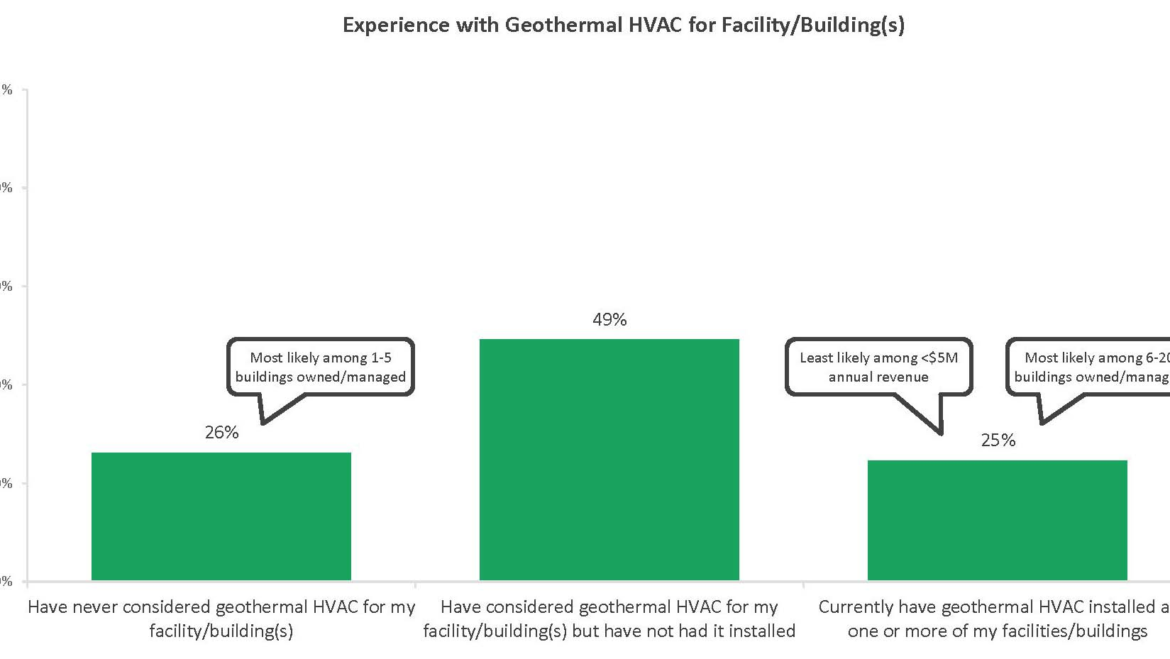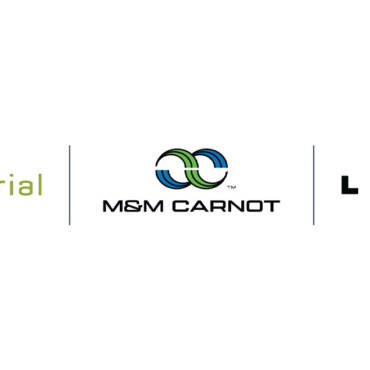Commercial contractors are seeing increased interest in geothermal HVAC — and the latest data backs this up. A new survey by The ACHR NEWS, in partnership with myCLEARopinion Insights Hub, found that 25% of facility managers have already implemented geothermal systems in their buildings, while over half reported familiarity with the technology.
“The misconception that geothermal is geographically limited is starting to be corrected,” explained Bryant Jones, executive director of Geothermal Rising, a trade association representing the geothermal industry across the United States and Canada. He pointed to installations now spanning from Manhattan skyscrapers to Midwestern universities, suggesting broader adoption than many in the industry previously recognized.
The survey, which captured insights from commercial contractors and facility managers across the country, painted a picture of a maturing market. One-third of facility managers claimed to be “extremely knowledgeable” about geothermal HVAC, indicating growing sophistication among commercial end-users.
Click chart to enlarge
1/4: One-quarter of facility managers/building owners currently have geothermal HVAC installed in their facility/building, while about the same proportion has never even considered it. (Courtesy of myCLEARopinion Insights Hub)
Decision Making
The survey revealed that facility managers rely heavily on professional channels for their geothermal information, with 78% turning to HVAC contractors and 71% consulting manufacturer websites. This professional guidance is crucial, as the decision to implement geothermal involves complex considerations.
System reliability and performance emerged as the top factors in installation decisions, followed closely by long-term cost savings and initial installation costs. These priorities align with what industry experts see in the field.
While 77% of facility managers cited cost savings over time as the most important factor when considering geothermal HVAC, the technology’s initial expense remained its biggest hurdle. An overwhelming 87% of survey respondents identified high initial cost as their primary concern.
Kent Reifsteck, director emeritus of the Facilities & Services’ Utilities & Energy Services division at the University of Illinois Urbana-Champaign, acknowledged this challenge: “There’s a pretty significant capital cost for providing the well field. So anytime you do just a standalone building, you do the analysis, and you find it’s a little difficult with the cost of putting the well fields in.”

Click chart to enlarge
COST: Energy efficiency, cost savings over time, and environmental friendliness emerge as the main perceived benefits of geothermal HVAC to facility managers/building owners. The majority have concerns over the high initial cost of the system. (Courtesy of myCLEARopinion Insights Hub)
However, the financial equation is becoming more favorable with Inflation Reduction Act (IRA) incentives.
“Under the IRA, there are tax credits up to 50% for all of that work, including the ductwork if needed,” Jones noted. These geothermal incentives appear stable, he said, with industry organizations working to maintain them, while subsidies for air-source heat pumps — the main competitor to geothermal heat pumps — may fall off.
“We are hearing that air source tax credits for air source heat pumps and solar and wind are being looked at to be eliminated,” Jones explained. “And the geothermal industry is working with Congress and the Trump administration to protect and maintain tax credits for geothermal technologies.”
Former U.S. Deputy Secretary of Energy David M. Turk underscored the broader policy implications in recent Congressional testimony. “Getting rid of those [tax credits] is exactly the wrong thing to do right now,” Turk warned, citing analysis showing potential increases of $220-400 in annual energy costs per household if certain credits were repealed.
Case Study: Wymer Hall
The University of Illinois Urbana Champaign’s new Wymer Hall project demonstrated how commercial geothermal can work at scale. The nearly 100,000-square-foot facility utilizes 70 boreholes drilled to depths of 450 feet, making it one of the most comprehensive geothermal installations in academic settings.
Early results from similar systems on campus were promising. The Campus Instructional Facility (CIF), which uses a comparable geoexchange system, showed approximately 58% lower energy usage compared to buildings with a traditional energy profile.
The university has long been at the forefront of advanced \ cooling strategies. During the era of Blue Waters, a petascale supercomputer that was decommissioned on December 31, 2021, the campus developed innovative cooling approaches.
Reifsteck described their unique cooling strategy: “For Blue Waters, we actually had an economizer cycle for the winter, so we didn’t have to mechanically cool the computers. We used on-site cooling towers in the winter so that we could get by without having to do mechanical cooling.”
Beyond major computing facilities, the campus continues to manage specialized cooling needs. “We’ve got a lot of smaller areas throughout all the different buildings that have research or small computer rooms that need year-round cooling,” Reifsteck explained. These facilities remain connected to the campus’s central chilled water system, which maintains cooling capability throughout the year.
The approach demonstrates how geothermal and advanced cooling systems can be integrated with existing infrastructure to meet specialized cooling needs efficiently.
The University of Illinois Urbana-Champaign operates one of the most sophisticated district energy systems in academia, centrally distributing both electricity and steam. It won the International District Energy Association’s system of the year award in 2024. The campus infrastructure includes an extensive network of steam tunnels and a central chilled water system, offering unique advantages for a regional campus.
“Some buildings need cooling even in the winter,” Reifsteck noted. “We use the central chilled water system as our heat source for heat pumps to provide heating in the buildings with hot water.” The system employs what they term “heat recovery chillers” to take advantage of simultaneous heating and cooling needs across campus.

Click chart to enlarge
AGREEMENT: Over half of facility managers/building owners would be more likely to purchase a service agreement for a geothermal HVAC system compared to a more traditional HVAC system, while two-in-five would be neither more nor less likely. (Courtesy of myCLEARopinion Insights Hub)
Survey Says
The survey highlighted high expectations for project management and communication, with 78% of facility managers expecting detailed project timelines and regular updates from contractors. This demand for professional service came as the industry works to build its workforce.
“We really do need more educational training programs for commercial HVAC installers,” Jones acknowledged. “The demand is increasing, and the workforce is not aligned with that demand growth.”
“The U.S. Bureau of Labor Statistics projects that employment opportunities for HVAC workers will grow by 6% through 2032, which is about twice the average growth rate for all occupations,” said Joe Parsons, senior marketing sustainability manager at Climate Control Group. “Other sources project a 9% growth from 2023 to 2033. This demand is driven by multiple factors such as an aging workforce, increased focus on energy efficiency, technological advancements, and the need for improved indoor air quality.”
At the same time, recent advances in heat pump and recovery chiller technology have made commercial geothermal increasingly viable. “There’s a lot of advancements, whether you call them heat pumps or recovery chillers,” Reifsteck noted.
Whether using the ground as a heat source/sink in geothermal applications, or leveraging a central chilled water system, the basic principle remains the same: moving heat from where it isn’t wanted to where it is needed.
“Anytime we can use the heat pump and take advantage of the instantaneous need for heating and cooling, both, that’s when we gain the most efficiencies,” Reifsteck noted.

CENTRAL: The University of Illinois’ central chilled water system provides year-round cooling capabilities. (Courtesy of the University of Illinois at Urbana-Champaign
The evolution extends beyond equipment. Modern geothermal systems can now integrate with building automation systems, provide real-time performance monitoring, and offer sophisticated load management capabilities.
“We’re seeing rapid adoption in commercial spaces thanks to advancements like variable-speed compressors, advanced controls, and modular system designs,” Parsons said. “These technologies not only boost efficiency and flexibility but also simplify integration with building automation systems.”
He said geothermal is now a far more attractive option for facility managers looking to cut operating costs and reduce carbon footprints.
“They’ve made improvements on the equipment needed to do that on a larger scale,” Reifsteck added, pointing to enhanced controls and system optimization tools. These technological advances are being put to work in major commercial projects.
Market Drivers
Several factors are accelerating commercial geothermal adoption:
- Energy Independence: “If building owners are concerned about global supply chains, then geothermal is a technology to look at because it doesn’t have global supply chains the way that wind, solar, and fossil fuels have,” Jones explained.
- Environmental Impact: “Geothermal has the lowest life cycle carbon footprint of any renewable energy technology, and it has the smallest environmental footprint of all energy technologies,” Jones said.
- Grid Benefits: “Geothermal provides two benefits to utilities,” Jones noted. “It can help take load off of the grid through heating and cooling applications, and then you can also add electricity to the grid through geothermal power generation technologies.”
Looking Ahead
For facility managers considering geothermal, Jones recommended starting with proper training and certification through organizations like the International Ground Source Heat Pump Association. Thereafter, as more commercial success stories emerge and technology continues to advance, the current 25% adoption rate could mark just the beginning.
“As a result of the increased energy independence, system reliability and new technologies, more building owners are recognizing the long-term value of geothermal solutions, especially when combined with these next-generation heat pumps and chillers that deliver both environmental and economic benefits,” Parsons noted.
With stable tax incentives for geothermal likely to continue while competing technologies’ subsidies face uncertainty, the market appears positioned for growth.
“The data is showing that the demand is there,” Jones concluded. “Geothermal heat pumps have been growing year after year.”
Whether you require installation, repair, or maintenance, our technicians will assist you with top-quality service at any time of the day or night. Take comfort in knowing your indoor air quality is the best it can be with MOE heating & cooling services Ontario's solution for heating, air conditioning, and ventilation that’s cooler than the rest.
Contact us to schedule a visit. Our qualified team of technicians, are always ready to help you and guide you for heating and cooling issues. Weather you want to replace an old furnace or install a brand new air conditioner, we are here to help you. Our main office is at Kitchener but we can service most of Ontario's cities
Source link


